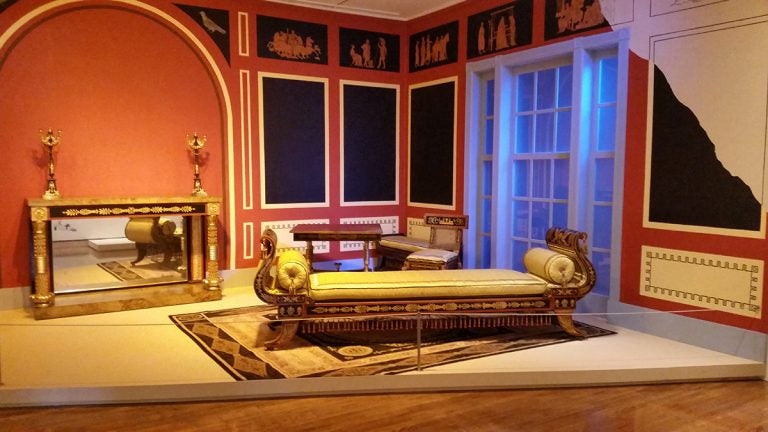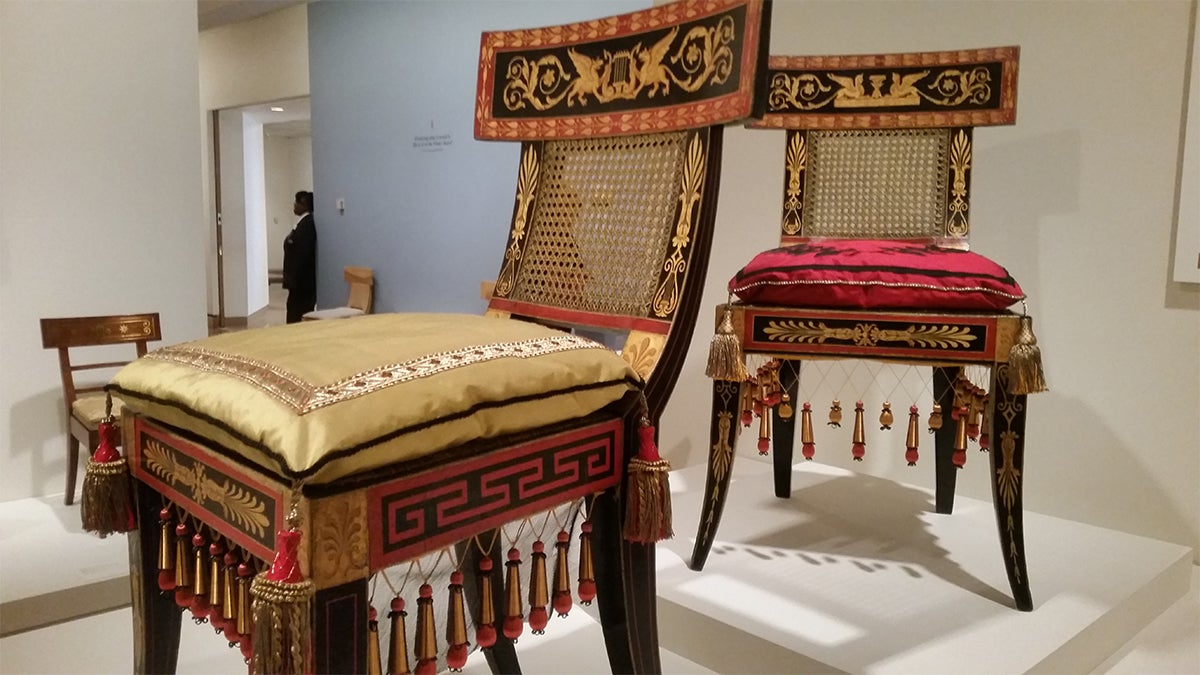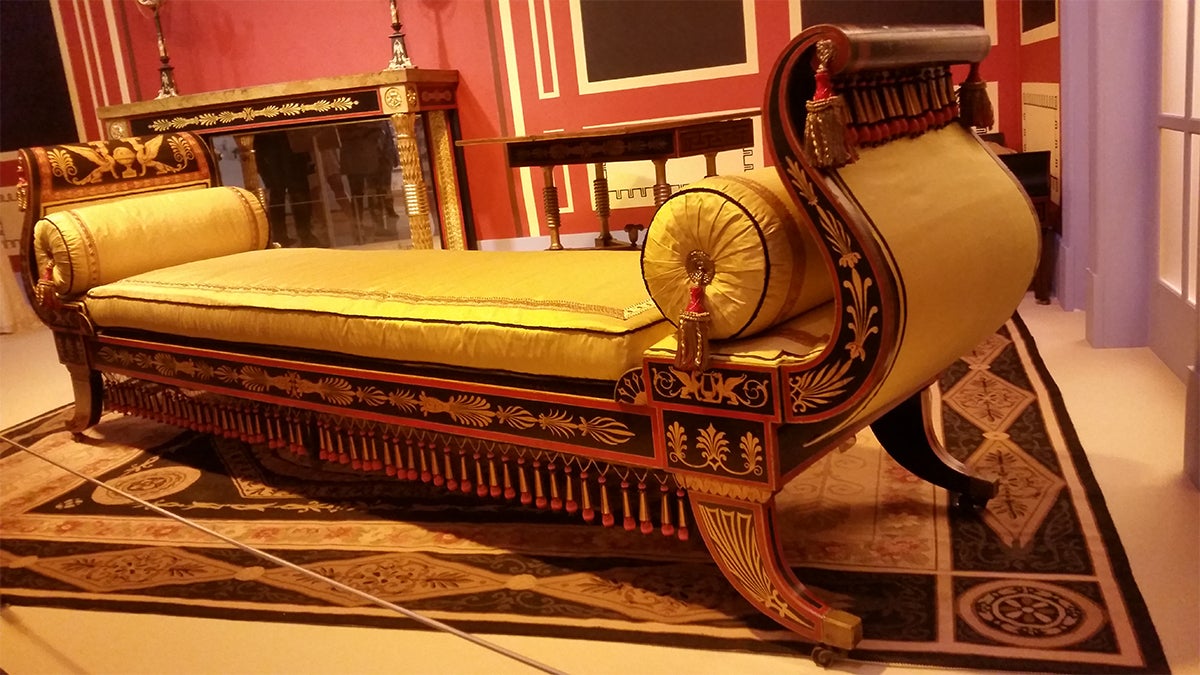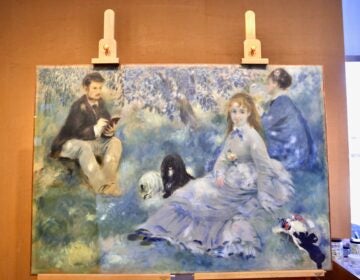Exotic furniture exhibit tells story of rise and fall of Philadelphia’s Waln family
Listen
(Peter Crimmins/WHYY)
A new exhibition of old furniture at the Philadelphia Museum of Art tells the spectacular rise and sudden fall of one of the city’s early power couples.
William and Mary Waln used to throw magnificent parties at their house at Seventh and Chestnut Streets, outfitted with furniture that set the trend for American design in the early 19th century.
The furniture was also their undoing.
William Waln was new money. The son of a Quaker preacher, he became a shipping merchant and made a fortune, in part, by moving opium from Turkey to China. He married old money. Mary Wilcocks was a descendant of Pennsylvania’s original landowners. They had money and liked to spend it.
To build their mansion at Seventh and Chestnut and custom-design its furniture, they hired Benjamin Latrobe, a British transplant who was America’s first professional architect (buildings were normally designed by the builder, or— like Thomas Jefferson — by well-cultured gentlemen landowners).
“He thought he should train Americans how to have an architect, train Americans to develop their own visual language” said Alexandra Kirtley, curator of “Classical Splendor: Painted Furniture for a Grand Philadelphia House.”
“He thought strongly it should be rooted in classical art. Philadelphia should be the Athens of the Western world.”
Latrobe spent a fair amount of time working in Philadelphia, designing banks, private country estates, and the Center Square waterworks (where City Hall now stands). He also married in Philadelphia, in 1800.
“For Latrobe the Waln house was an opportunity to design ‘the first rational house,’” wrote architectural historian Jeffrey Cohen in the exhibition catalogue. “A public demonstration of his capabilities as an agent of a new taste and logic that challenged prior practices.”

Neoclassicism ruled the day, and Latrobe was resisting it. The furniture he designed for the Waln house was described at the time as “magical,” an “Eastern fairy tale. Starting with a classic klismos design for the chairs, with their saber-curved legs coming to a point at the floor, they were decorated in a Eastern palette of deep red, black, and gold leaf, with luxurious cushions of yellow silk.
“It’s completely out of context, it comes out of nowhere,” said Kirtley. “It’s rooted in antiquity, but looks futuristic. It’s timeless. We still see it today.”
The furniture was decorated by George Bridport, a former theatrical set designer who became the go-to artist for interior design. He had just painted the ceiling of the U.S. House of Representatives before the Waln commission, and later went on to decorate the Oval Drawing Room of the President’s House in Washington.
Bridport painted the walls of the Waln drawing room to match the furniture, including frieze images of scenes from The Odyssey. None of his major work survives — not in Washington, Philadelphia, or Baltimore. Only the furniture remains.
A year after the furniture debuted, first lady Dolley Madison asked Latrobe to design the same thing for the White House.
“It was a watershed moment,” said Kirtley. “Neoclassical is gone. Buh-bye. Nobody does it anymore.”
The Walkn drawing room attracted the who’s-who of Philadelphia society, people with names that were already old in 1808: the Harrison, the Fisher, the Manago, the Clifton at some point were characters in the Waln’s theatrical set.
“Classical Splendor” uses surviving pieces of the Waln furniture to create a mock-up of the drawing room where so many early Philadelphians socialized. Bridport designed the furniture to shimmer in different kinds of light. The museum created three programmed lighting schemes so viewers can see what the room would look like at sunrise, at afternoon tea, and during evening parties by candlelight.
The magic didn’t last. During the economic panic of 1819, the Walns lost everything. They had to sell the house to Mary’s sister to cover debts, and sell the furniture on the sidewalk.
Observers said that, on the common cobblestones of Philadelphia, all that “magical” furniture with delicate gold leaf and silk tassels just looked silly.

The furniture scattered. There are now 21 known pieces remaining. The Art Museum has 10 of them, obtained in different batches over the years. Conservators did not at first realize they were made by the same artisans, or what exactly they were supposed to look like.
“A lot of my time was spent under the microscope. Kind of boring. But occasionally we would have really exciting discoveries,” said conservator Peggy Olley. What she was finding under the microscope led the direction of Kirtley’s curatorial research.
Olley found tiny silk fibers stuck to tacks under the rails of the chairs, which suggested a decorative treatment of silk swag. Under closer examination, those fibers were twisted.
“What this told us was this was not a solid swag, but actually a fringe element,” said Olley. Her discovery pushed Kirtley to look at other historic furniture and paintings of similar furniture with fringe. Together they designed a fringe element that is likely historically accurate.
Museum director Timothy Rub called them his CSI team.
The furniture, however, may have been an albatross around Mrs Waln’s neck. Kirtley looked at her medical records and purchasing records side-by-side, and saw her activity in the house stopped completely while she was pregnant. She gave birth to six children, but suffered miscarriages. Kirtley believes Mary Waln had a very difficult time with childbirth
She’s often sick, and people know this because Rebecca Gratz mentions it,” said Kirtley, referring to the prominent Philadelphia teacher and philanthropist of the time. “She says Mrs. Waln will be happier without all this furniture, without having to live up to being the arbiter of taste, the queen bee of Chestnut Street. She will be healthier not having the pressure of that. The furniture represents that.”
After their home dissipated, William Waln found work in the insurance industry but died a few years later. However Gratz’s prediction about Mary Waln’s health proved correct: the lady of the house that once revolutionized American design lived another 20 years without her dazzling, avant-garde sofa, quietly raising her children amid modest furnishings.
WHYY is your source for fact-based, in-depth journalism and information. As a nonprofit organization, we rely on financial support from readers like you. Please give today.





